Scottish Study of Early Learning and Childcare: Phase 1 Report - Updated 2021
Phase 1 of the Scottish Study of Early Learning and Childcare (SSELC) aimed to gather a robust baseline of child and parent outcomes for a cohort of eligible two-year-olds who were receiving 600 hours of funded early learning and childcare provision.
This document is part of a collection
Child health and development
Assessments of development
Children’s keyworkers at ELC settings were asked to complete observations of the child’s development using the Ages and Stages (ASQ) and Strengths and Difficulties (SDQ) questionnaires. Both the ASQ and SDQ are widely used by Health Visitors across Scotland as part of their health reviews of pre-school children – the Scottish Child Health Programme[21]. These particular instruments were also selected for inclusion in the Child Health Programme following an extensive review by academics and practitioners[22].
The ASQ provides a structured assessment of a range of developmental domains, usually using a parental questionnaire supported by observation of the child at play to identify children at increased risk of developmental problems. There are 30 items split into five different domains: communication, gross motor, fine motor, problem-solving and personal-social. By answering ‘yes’, ‘sometimes’ or ‘no’, the respondent indicates whether or not the child can complete the action or provide the response required. Each domain produces a summary score which can be used to indicate whether the child’s development is on schedule, needs monitoring or requires further assessment. Whilst it is designed to be completed by parents, because it is informed by observation of the child it was deemed suitable for completion by the child’s keyworker at their ELC setting.
The SDQ is a commonly used behavioural screening questionnaire designed for use with children aged between three and 16. It consists of 25 questions about a child’s behaviour to which the respondent can answer ‘not true’, ‘somewhat true’ or ‘certainly true’. Responses can be combined to form five different measures of the child’s development, namely emotional symptoms (e.g. excessive worrying), conduct problems (e.g. often fighting with other children), hyperactivity/inattention (for example, constantly fidgeting), peer relationship problems (e.g. not having close friends), and pro-social behaviour (e.g. being kind to others). Furthermore, the first four measures can be combined into a ‘total difficulties’ scale. Higher scores imply greater evidence of difficulties on each of the scales, with the exception of the pro-social behaviour scale where the reverse is true. In this report, recommended banded versions of the scales have been used to create the following categories: ‘close to average’, ‘slightly raised’, ‘high’ and ‘very high’, with ‘very high’ indicating multiple problems identified.
Ages and Stages Questionnaire
Figure 6 provides details of the proportion of children who were deemed to have development on schedule, needing monitoring or requiring further assessment for each of the ASQ domains. Children were most likely to be on schedule in relation to gross motor development and least likely in relation to problem solving.
Figure 6: ASQ scores by domain
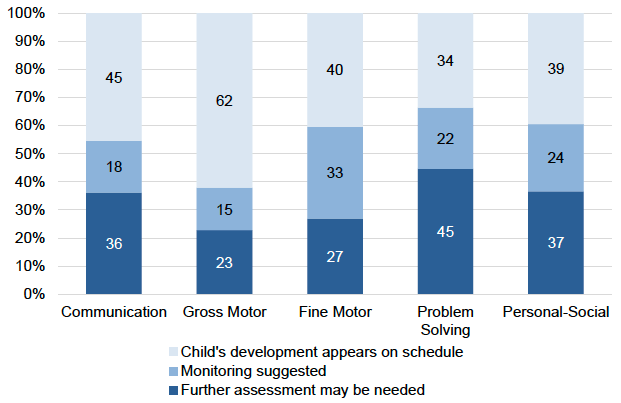
Base: All children (keyworker observations)
Figure 7 breaks down scores in the gross motor domain by the child’s sex, area deprivation and SDQ total difficulties score. Reflecting commonly found differences by sex on a range of health and developmental measures[23], girls were more likely than boys to be viewed as having development which was on schedule (66% compared with 58%), though the difference was narrower than in some other domains. There was little notable difference in gross motor development according to area deprivation but some differences were evident according to SDQ total difficulties score. Those children with higher difficulties were generally more likely than those with lower difficulties to have gross motor development deemed as requiring further assessment. However, the relationship was not fully linear (i.e. the proportion of children identified as requiring further assessment did not consistently increase as the total difficulties score increased) and it was weaker than with communication domain scores.
Figure 7: ASQ gross motor domain score by child’s sex, area deprivation and SDQ total difficulties score
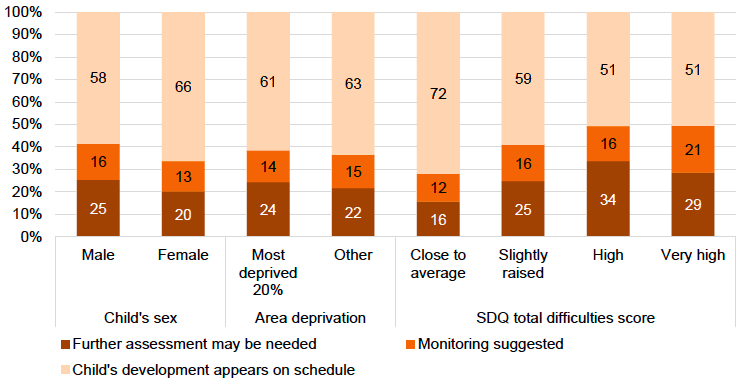
Base: All children (keyworker observations)
In relation to fine motor development, as shown in Figure 8, boys (34%) were again less likely to be on schedule than girls (48%). Children living in the most deprived 20% of areas were less likely than those living in other areas to be on schedule (36% compared with 45%) though most of this difference was in the proportion of children for whom monitoring was suggested (36% compared with 30%) rather than further assessment being needed (28% compared with 25%). As SDQ total difficulties score increased, the proportion of children deemed as needing further assessment in relation to their fine motor development also increased. Around one in five (19%) children with a close to average SDQ score were identified as needing further assessment compared with two in five children (41%) with a very high SDQ score.
Figure 8: ASQ fine motor domain score by child’s sex, area deprivation and SDQ total difficulties score
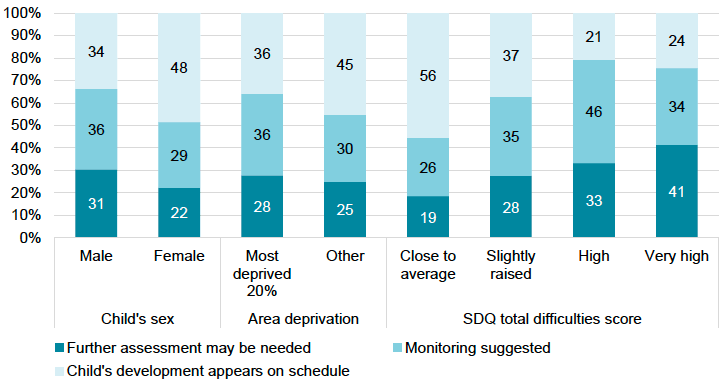
Base: All children (keyworker observations)
In the problem-solving domain (Figure 9), boys (25%) were almost half as likely to be on schedule as girls (42%). Differences were also notable by area deprivation with children living in the most deprived 20% of areas less likely than those in less deprived areas to have development on schedule (31% compared with 36%) and more likely to be deemed as needing further assessment (48% compared with 41%). Those children who had a high total difficulties score on the SDQ were also notably more likely to be identified as requiring further assessment in relation to ASQ problem-solving. As the graph shows, 27% of children with a ‘close to average’ SDQ total difficulties score were deemed to potentially require further assessment in relation to ASQ problem-solving compared with 73% of children with a ‘very high’ total difficulties score.
Figure 9: ASQ problem-solving domain score by child’s sex, area deprivation and SDQ total difficulties score
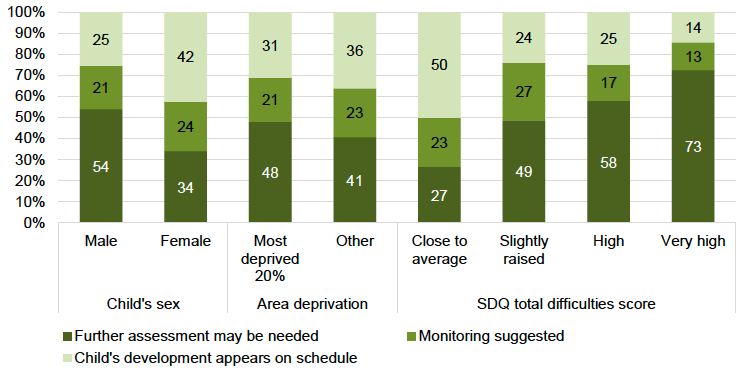
Base: All children (keyworker observations)
In the personal-social domain (Figure 10), girls were more frequently deemed to be on schedule (47%) than boys (33%). Children living in the most deprived 20% of areas were less likely than those living in other areas to be on schedule (36% compared with 42%) and more likely to require monitoring (27% compared with 21%).
Figure 10: ASQ personal-social domain score by child’s sex, area deprivation and SDQ total difficulties score
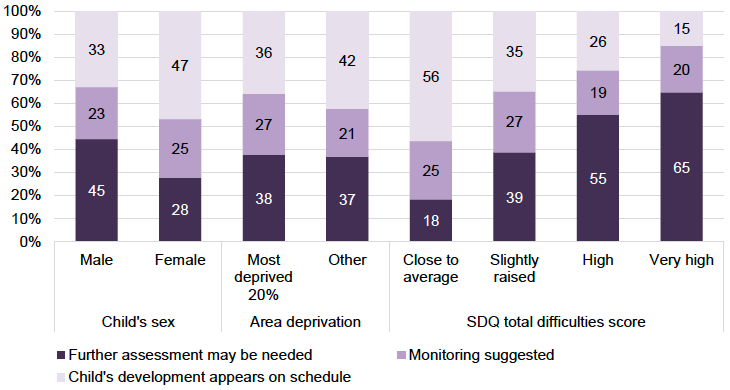
Base: All children (keyworker observations)
The relationship between ASQ personal-social scores and SDQ total difficulties scores was very strong. Children with a very high SDQ score were over three times as likely as those with a close to average score to be deemed as requiring further assessment.
Scores in the communication domain are broken down by the child’s sex, area deprivation and SDQ total difficulties score in Figure 11. As in other domains, boys were more likely than girls to be identified as requiring further assessment (43% compared with 28%) and children living in the most deprived 20% of areas were more likely than those living in less deprived areas to be considered as requiring further assessment. There was a very strong relationship between ASQ communication scores and SDQ total difficulties scores. Children with a very high SDQ total difficulties score were three times more likely than those with a close to average total difficulties score to have been identified as needing further assessment in relation to communication (62% compared with 20%).
Figure 11: ASQ communication domain score by child’s sex, area deprivation and SDQ total difficulties score
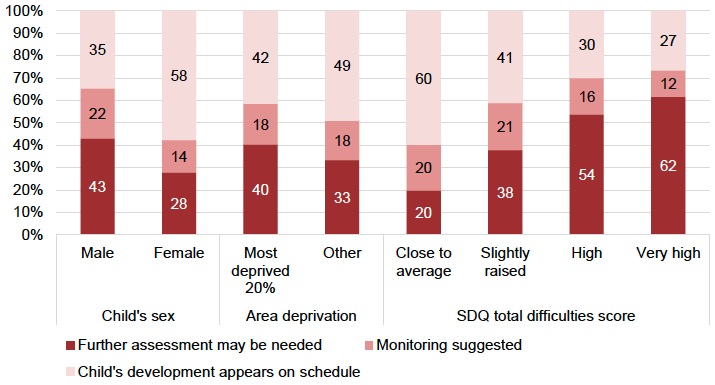
Base: All children (keyworker observations)
Additional analysis was undertaken to explore differences in ASQ communication domain scores by a range of parent and family characteristics. Results for children whose parents had no qualifications or degree level qualifications were similar (Figure 12). Compared to those whose parents had qualifications below degree level, children in these groups were less likely to have development on schedule and more likely to be identified as needing further assessment. For example, 45% of children whose parents had a degree level qualification were considered to require further assessment compared with 34% of children whose parents had a qualification at Standard Grade or National 4/5 level. This may be related to the fact that children with degree-educated parents are more likely than those whose parents have lower qualifications to also be in higher income households and would therefore be receiving funded ELC due to specific support needs identified for the child or their parent. Children from couple families were less likely than those in single parent families to have development that was on schedule (41% compared with 50%) and more likely to be deemed as needing further assessment (41% compared with 34%).
Figure 12: ASQ communication domain score by parent’s level of education
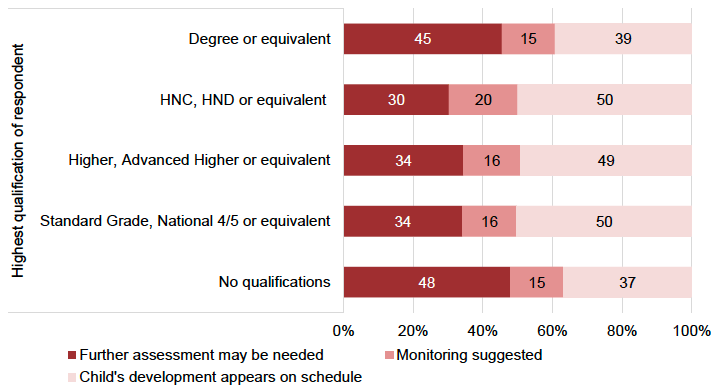
Base: All children (keyworker observations)
There were no notable differences in children’s ASQ communication domain scores according to whether or not their parent had a longstanding illness or their level of parental self-efficacy. Some differences were evident according to parental mental wellbeing but the relationship between the two variables is not strong. Whilst children whose parents had high mental wellbeing were less likely than those with low mental wellbeing to have development on schedule (32% compared with 47%) they were similarly likely to be considered as needing further assessment (42% compared with 40%).
There was some variation in ASQ communication scores by children’s sleeping patterns and whether they were ever breastfed but there was no overall pattern (see Table B3 in Appendix B). In contrast, much stronger relationships were observed by frequency of home learning activities and SDQ total difficulties score (Figure 13). Children who experienced lower levels of home learning activities and those who had higher SDQ total difficulties scores were significantly more likely than children with higher levels of activities and those with lower SDQ total difficulties scores to have development deemed as requiring further assessment. For example, 62% of children whose total difficulties score was in the very high range had development identified as needing further assessment compared with 20% of children whose total difficulties score was in the close to average range.
Figure 13: ASQ communication domain score by SDQ total difficulties score and home learning environment score
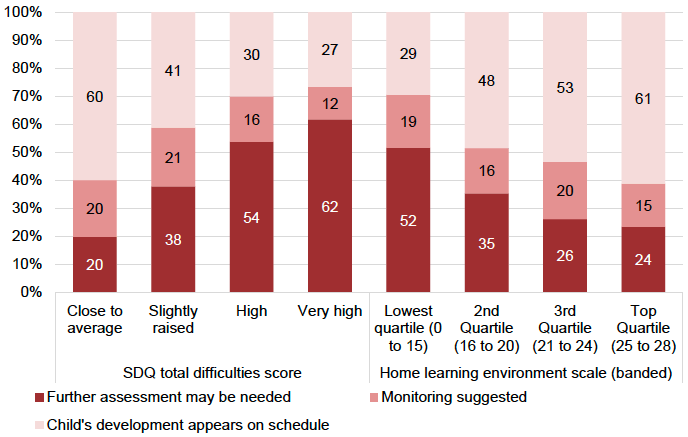
Base: All children (keyworker observations)
Strengths and Difficulties Questionnaire
As shown in Figure 14, most children (70%) had an SDQ total difficulties score in the ‘close to average’ (43%) or ‘slightly raised’ (26%) range. However, 14% had a score in the ‘high’ range and a further 16% in the ‘very high’ range. These rates vary across each of the difficulties domains. As the graph shows, children were most likely to score close to average in the emotional symptoms domain (80%) and least likely to do so in relation to peer problems (36%). They were most likely to score very high in the hyperactivity domain (22%) and least likely for emotional symptoms.
Figure 14: SDQ scores by domain
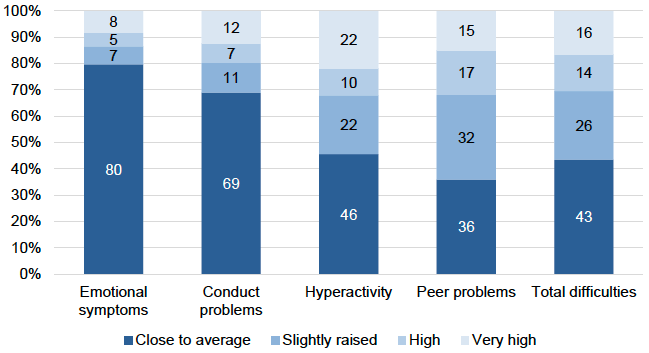
Base: All children (keyworker observations)
In relation to emotional symptoms and conduct problems, there were no notable differences between boys and girls or by area deprivation (see Tables B4 and B5 in Appendix B). Boys and girls differed more in relation to hyperactivity (Figure 15) and peer problems (Figure 16). For both, boys were less likely to score close to average and more likely to score very high. For example, 27% of boys scored very high on SDQ hyperactivity compared with 17% of girls.
Figure 15: SDQ hyperactivity score by child’s sex and area deprivation
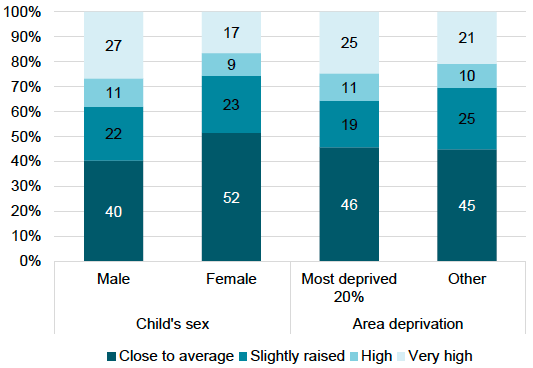
Base: All children (keyworker observations)
Differences by area deprivation were less consistent. On hyperactivity, children from more and less deprived areas were similarly likely to have close to average scores. However, children living in the most deprived 20% of areas were a little more likely than those living in other areas to have very high hyperactivity scores (25% compared with 21%). On the peer problems domain, children living in the most deprived 20% of areas were less likely than children living in other areas to have close to average scores (33% compared with 38%) and more likely to have a high or very high score (34% compared with 30%).
Figure 16: SDQ peer problems score by child’s sex and area deprivation
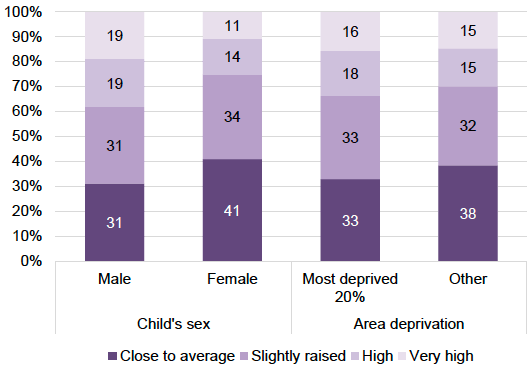
Base: All children (keyworker observations)
These trends are also reflected in the total difficulties scores as shown in Figure 17. Boys were less likely than girls to have a close to average score (38% compared with 49%) and more likely to have a high or very high score (36% compared with 25%). Similarly, children living in the most deprived 20% of areas were less likely than children in other areas to have a close to average score (39% compared with 46%) and more likely to have a high or very high score (33% compared with 28%).
Figure 17: SDQ total difficulties score by child’s sex and area deprivation
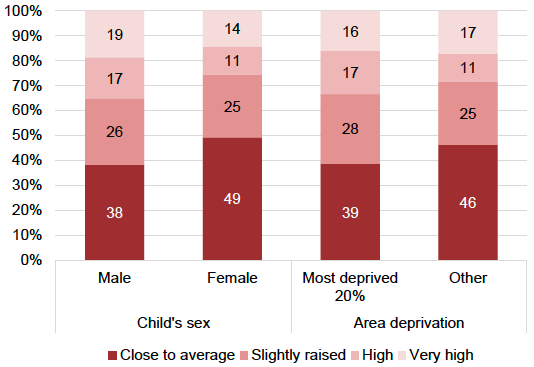
Base: All children (keyworker observations)
Parental education level was associated with children’s SDQ total difficulties score (Figure 18). In cases where parents had no qualifications, children were less likely than those where parents had any qualifications to have close to average scores and more likely to have high, but not ‘very high’, scores. For example, 28% of children whose parents had no qualifications had a close to average score compared with 43% of children whose parents had a degree-level qualification. Results amongst those with different types of qualifications were generally similar and there was no obvious trend by level of qualification. There were no notable differences between children in single parent and couple households.
Figure 18: SDQ total difficulties by parent’s level of education
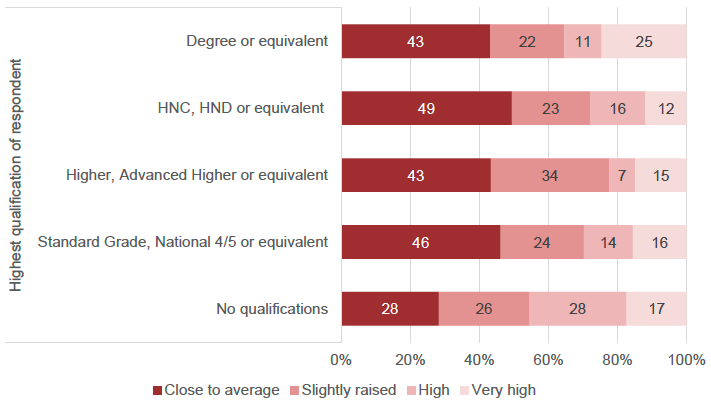
Base: All children (keyworker observations)
Elements of parental health and wellbeing also appeared to be related to children’s SDQ scores (Figure 19). Children whose parents had a longstanding illness, those whose parents had low mental wellbeing and those whose parents were coping well less often were all less likely to have SDQ total difficulties scores in the close to average range than children whose parents did not have a longstanding illness, with average or high mental wellbeing and who were coping well most of the time. For example, 34% of children whose parents had a longstanding illness had a total difficulties score in the close to average range compared with 51% of children whose parents did not have a longstanding illness.
Figure 19: SDQ total difficulties by parental longstanding illness, parental mental wellbeing and parental self-efficacy
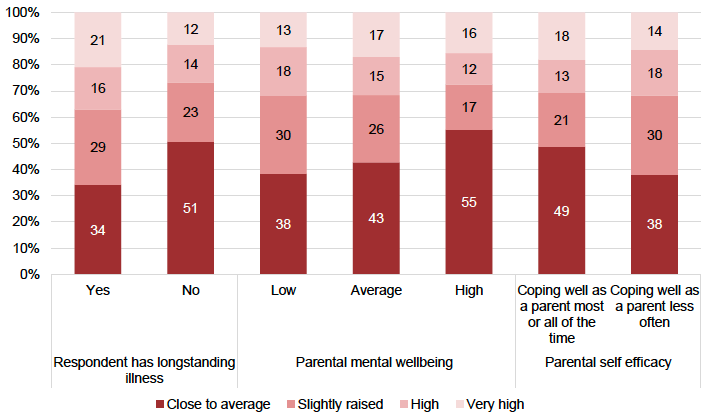
Base: All children (keyworker observations)
As shown in Figure 20, there was also a relationship between children’s sleeping patterns, whether they were ever breastfed, their engagement in home learning activities and their SDQ total difficulties scores. Children who slept through the night every night were less likely than those who never slept through the night to have close to average scores (38% compared with 45%). However, less frequently sleeping through the night was not consistently linked to lower difficulties and the relationship is mixed (see Table B6 in Appendix B). A higher proportion of children who were breastfed than those who were not had close to average scores (50% compared with 40%) and a lower proportion had high or very high scores (27% compared with 35%)[24]. Those children who experienced a lower frequency of home learning activities were less likely to have a total difficulties score in the close to average range and more likely to have scored in the high or very high range than those who experienced a higher frequency of activities.
Figure 20: SDQ total difficulties by sleeping pattern, whether ever breastfed and home learning activities scale-
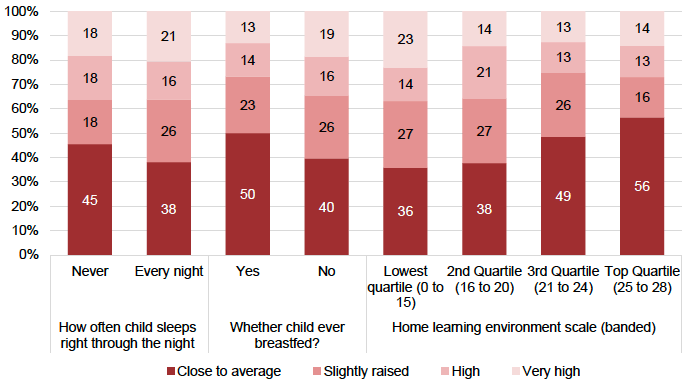
Base: All children (keyworker observations)
The pro-social sub-scale of the SDQ is scored in the opposite way to the difficulties scales. In this instance, a higher score indicates more positive pro-social behaviour whereas a low score indicates more problematic behaviour. Overall, 45% of children had a score in the close to average (highest) range, 13% in the slightly lowered range, 14% scored low and 28% very low. As noted in relation to several of the other sub-scales, there were differences between boys and girls (Figure 21) with boys twice as likely as girls to score in the very low range (37% compared with 18%). Differences by area deprivation were much smaller: children living in the most deprived 20% of areas were only slightly more likely than those living in other areas to have very low pro-social scores (30% compared with 27%).
Figure 21: SDQ pro-social by child’s sex and area deprivation
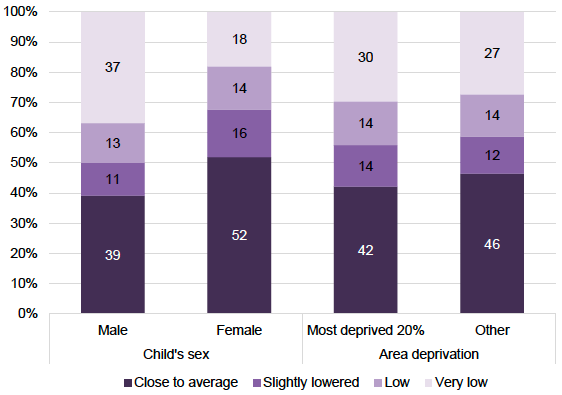
Base: All children: (keyworker observations)
General health and long-standing illness
Most parents (57%) ranked their child’s general health as being ‘very good’ with 32% reporting it as ‘good’. A small proportion (10%) said their child’s health was ‘fair’ and even fewer (1%) said it was ‘bad’. No-one ranked their child’s health as being ‘very bad’. Perceptions of children’s health were more positive when the child in question is female, as can be seen in Table 3. For example, 62% of female children were said to have very good health compared with 52% of male children.
There were no notable differences in general health between children from single parent or couple households (see Table B7 in Appendix B). Some small differences were evident by area deprivation with children from less deprived areas more likely to have good or very good health (92%) than children from the most deprived 20% of areas.
Table 3: Child’s health in general by sex
| Male child |
Female child |
All |
||
|---|---|---|---|---|
| Very good |
52 |
62 |
57 |
|
| Good |
32 |
32 |
32 |
|
| Fair |
13 |
6 |
10 |
|
| Bad |
1 |
- |
1 |
|
| Very bad |
1 |
- |
- |
|
| Unweighted base |
223 |
199 |
424 |
|
Base: All respondents (parent survey)
Thirteen percent of children in the cohort had a long-term illness and 11% had a long-term limiting illness. Amongst those with a long-term illness, 23% of parents stated it limited the child’s normal activity ‘a lot’, 64% that it limited the child ‘a little’ and 13% stated it did not limit the child at all. The proportion of children with a long-term illness in the cohort is lower than that recorded for all two- and three-year-olds in the Growing Up in Scotland study (17%)[25].
Boys (16%) were more likely than girls (10%) to have a long-standing illness. In contrast to trends in other child outcomes reported here, children living in the 20% most deprived areas were less likely (10%) than those living in other areas (15%) to have a long-standing illness. Children living in couple families (15%) were also slightly more likely than those living in single parent households to have such an illness reported.
Illnesses were most commonly perceived to limit the child in relation to stamina/breathing difficulties and mobility. A full breakdown is provided in Table 4.
Table 4: How longstanding condition or illness affects child
| All |
|
|---|---|
| Hearing (e.g. due to deafness or partial hearing) |
14 |
| Mobility, such as difficulty moving around |
35 |
| Learning or concentrating or remembering |
29 |
| Stamina or breathing difficulty |
35 |
| Mental health, social emotional or behavioural issues |
31 |
| Other impairment(s) |
22 |
| Unweighted base |
51 |
Base: All children with a long-term condition (parent survey)
Figure 22 summarises parental concerns with child development by child sex, specifically concerns with how the child talks and what they understand.
Figure 22: Concerns about what child understands and about how child talks by child’s sex
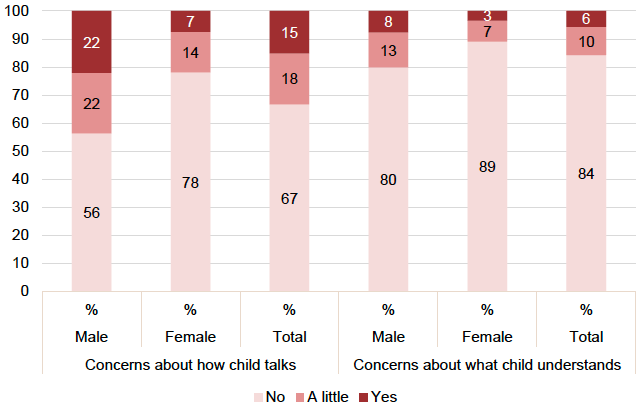
Base: All respondents (parent survey)
Roughly one-third (33%) of respondents had concerns about how their child talks and 16% had concerns about what their child understood. In both areas, parents were more likely to be concerned when the child was male, particularly with regards to how the child talks: 44% of parents were concerned about how their child talks when the child was male compared with 21% where the child was female.
Parents living in the most deprived 20% of areas were less likely than those living in other areas to have concerns about how their child talks (12% compared with 18%). Single parents were less likely than parents in couple households to have concerns about how their child talks – 72% had no concerns compared with 62% of parents in couple households. There were no notable differences in parental concerns about what the child understands by either area deprivation or single parent/couple households (see Tables B8 and B9 in Appendix B).
Developmental risk factors
Parents were asked for a range of information capturing aspects of their child’s early childhood circumstances, experiences and behaviours which are known to be associated with child development. These include sleep patterns, breastfeeding, and activities at home that promote learning. They were also asked about any concerns they had about their child’s development.
Figure 23 shows how often, over the course of a typical week, the child was reported to sleep through the night by sex. Around one in five (19%) children never did this whilst two in five (40%) did so every night. Girls were more likely to sleep through the night than boys: 22% of boys never slept through the night compared with 16% of girls.
Whilst children in single parent households were more likely than those in couple households to never sleep through the night (20% compared with 16%) they were not consistently more disrupted sleepers and were just as likely to sleep through the night every night (40% compared with 41%). There were no notable differences in sleeping behaviour by area deprivation (see Table B10 in Appendix B).
Figure 23 Frequency of sleeping through the night by child’s sex
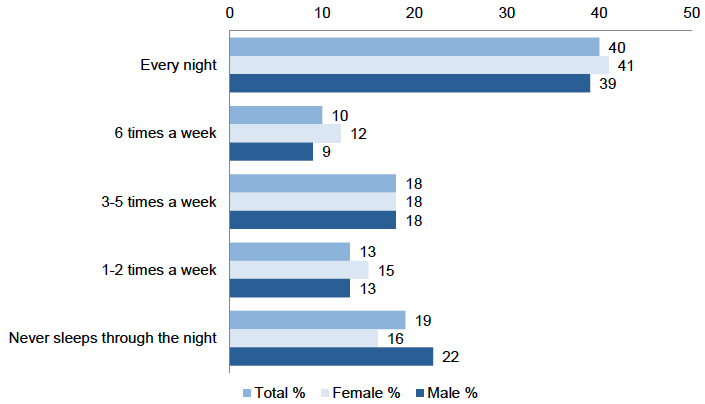
Base: All respondents (parent survey)
Forty percent of children were ever breastfed. As shown in Table 5, boys were slightly more likely to have ever been breastfed than girls (42% compared with 38%) and single parents were less likely to have ever breastfed their child than those in two parent families (38% compared with 46%). Breastfeeding rates did not vary by area deprivation (see Table B11 in Appendix B).
Table 5: Whether child was ever breastfed by child sex and single parent/couple household
| Male child |
Female child |
Single parent |
Couple household |
All |
|
|---|---|---|---|---|---|
| Yes |
42 |
38 |
38 |
46 |
40 |
| No |
58 |
62 |
62 |
54 |
60 |
| Unweighted base |
217 |
198 |
206 |
176 |
416 |
Base: All respondents (parent survey)
Parents were asked how often the child had been engaged in ‘home learning activities’ in the previous seven days. These included looking at books/reading stories, painting or drawing, reciting nursery rhymes/singing songs and playing at recognising letters, words, numbers or shapes.
Almost all children (99%) had been engaged in some form of home learning activity in the previous seven days. The most common activity was reciting nursery rhymes or singing songs which 64% of children had done every day. Looking at books and reading stories was also very common with half of children (50%) having done this every day. Activities involving painting or drawing and those involving recognising letters, words, numbers or shapes were less common with 23% and 39% of children doing these every day.
Experience of some activities varied according to children’s characteristics, as shown in Table 6. Boys and children from more deprived areas had looked at books or read stories less frequently than girls and children from other areas. For example, 55% of children in less deprived areas had looked at books every day in the last 7 days compared with 43% of children living in the most deprived 20% of areas. This difference was not evident between children in single and couple households.
Table 6: Frequency of home learning activities by child sex, area deprivation and single/couple household
| Male child |
Female child |
Most deprived 20% |
Other area |
Single parent |
Couple household |
All |
||
|---|---|---|---|---|---|---|---|---|
| Looked at books or read stories |
||||||||
| Not in last 7 days |
1 |
1 |
2 |
1 |
1 |
2 |
1 |
|
| 1 to 3 days |
27 |
22 |
27 |
23 |
27 |
21 |
27 |
|
| 4 to 6 days |
26 |
22 |
28 |
21 |
23 |
26 |
26 |
|
| 7 days |
45 |
55 |
43 |
55 |
50 |
51 |
45 |
|
| Painting or drawing |
||||||||
| Not in last 7 days |
8 |
4 |
7 |
5 |
4 |
7 |
8 |
|
| 1 to 3 days |
40 |
35 |
39 |
36 |
40 |
34 |
40 |
|
| 4 to 6 days |
31 |
38 |
30 |
38 |
34 |
35 |
31 |
|
| 7 days |
22 |
24 |
24 |
21 |
21 |
24 |
22 |
|
| Recited nursery rhymes or sung songs |
||||||||
| Not in last 7 days |
9 |
3 |
5 |
7 |
4 |
9 |
9 |
|
| 1 to 3 days |
20 |
13 |
24 |
11 |
19 |
14 |
20 |
|
| 4 to 6 days |
13 |
13 |
9 |
17 |
14 |
11 |
13 |
|
| 7 days |
58 |
71 |
63 |
65 |
63 |
66 |
58 |
|
| Recognising letters, words, numbers or shapes |
||||||||
| Not in last 7 days |
12 |
12 |
10 |
14 |
10 |
16 |
12 |
|
| 1 to 3 days |
25 |
22 |
24 |
24 |
27 |
19 |
25 |
|
| 4 to 6 days |
27 |
23 |
25 |
25 |
23 |
27 |
27 |
|
| 7 days |
36 |
42 |
40 |
37 |
40 |
38 |
36 |
|
| Unweighted base* |
210 |
192 |
189 |
206 |
208 |
187 |
403 |
|
Base: All respondents (parent survey)
*Note: bases vary slightly for each individual activity. The bases shown are the lowest amongst the four activities.
Boys, children from more deprived areas and those in single parent households were slightly less likely to have engaged in activities involving painting and drawing and to have done so less frequently in the last 7 days than girls, children living in other areas and those in couple households. For example, 96% of girls had engaged in such activities including 38% who had done so on four to six days compared with 92% and 31% respectively for boys.
This pattern was generally evident for reciting nursery rhymes and singing songs and activities involving recognising letters, words, numbers or shapes. Differences between boys and girls are particularly notable in relation to reciting nursery rhymes and singing songs – 71% of girls had done so every day in the last 7 days compared with 58% of boys.
The frequencies at which children had done each activity in the last seven days were summed together to create a total home learning activity scale. The scale ranged from 0 to 28 with the highest score indicating the child had been engaged in all four activities on each of the previous seven days. The cohort was then split into four evenly sized groups (quartiles) according to their scores on the scale: 0 to 15 (25% of all children); 16 to 20 (26%); 21 to 24 (27%) and 25 to 28 (22%).
Variations in frequency of activities were also seen by parental educational qualifications (Figure 24). Children whose parent had no qualifications were most likely to be in the lowest activity group (34%) whilst children whose parent was degree educated were least likely to be in this group (13%). Children whose parents had no qualifications were also least likely to be in the highest activity group (17%). However, the frequency of activities did not increase as level of qualifications increased. Children whose parent had Higher or Advanced Higher Grades or equivalent were most likely to be in the highest activity group (26% compared with 20% amongst children with a degree-educated parent).
Figure 24: Home learning activity score by highest parental educational qualification
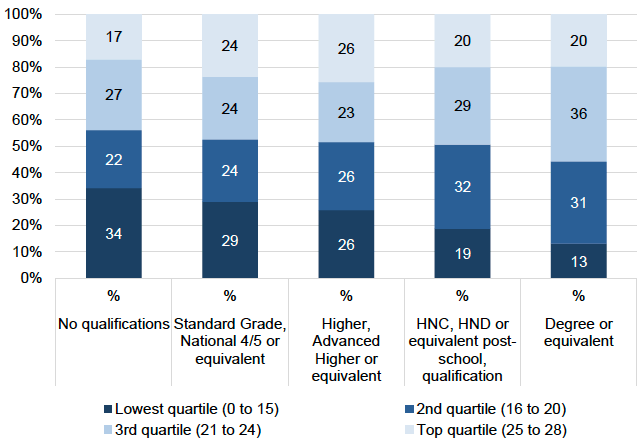
Base: All respondents (parent survey)
Contact
Email: socialresearch@gov.scot
There is a problem
Thanks for your feedback